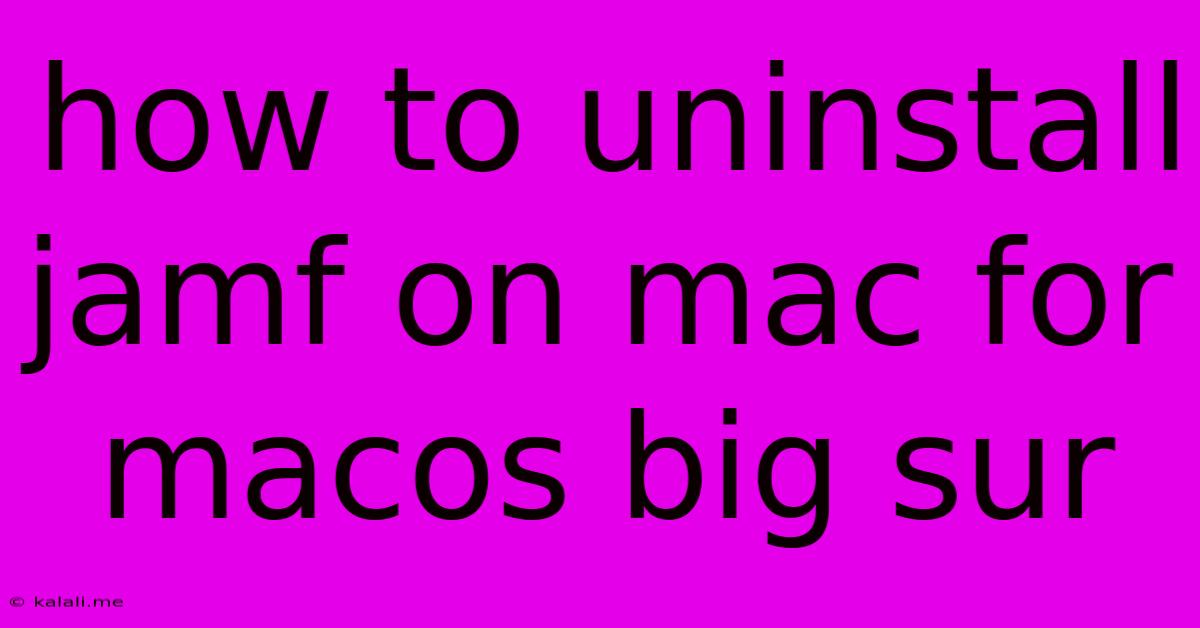How To Uninstall Jamf On Mac For Macos Big Sur
Kalali
May 23, 2025 · 3 min read

Table of Contents
How to Uninstall Jamf on Mac (macOS Big Sur and Later)
This guide provides a comprehensive walkthrough on how to completely uninstall Jamf from your macOS Big Sur machine (and later versions). Removing Jamf can be crucial if you're switching management solutions, troubleshooting issues, or simply want a clean system. This process goes beyond simply dragging the app to the Trash; it ensures all related files and configurations are removed. This guide is intended for users with administrative privileges.
What is Jamf? Jamf is a popular mobile device management (MDM) solution often used in enterprise environments to manage Macs and iOS devices. It provides centralized control over software updates, security settings, and application deployments.
Before You Begin:
- Back Up Your Data: Before undertaking any uninstall process, it's vital to back up all your important data. This precaution protects against data loss during the removal process. Use Time Machine or your preferred backup method.
- Administrative Privileges: You need administrator access on your Mac to uninstall Jamf successfully.
- Note the Jamf Version: Knowing your Jamf version might be helpful for troubleshooting if issues arise. Check the Jamf application for version details.
Step-by-Step Uninstall Process:
-
Quit Jamf Pro: Ensure the Jamf application is completely closed before proceeding. Check your Dock and Activity Monitor to confirm it's not running.
-
Uninstall the Jamf Agent: The Jamf Agent is the core component that interacts with the Jamf server. There are several ways to remove this, depending on your Jamf version and installation method:
-
Using the Jamf Self Service application (if available): If you have a Self Service application installed, it might offer an uninstall option for the Jamf agent. Look for an uninstall package or a removal script within the Self Service application.
-
Manually Removing the Jamf Agent: This method involves locating and deleting relevant files and directories. This is generally more complex and requires careful attention to avoid accidental removal of other system files. Proceed with caution. You'll typically find the agent files within the
/Librarydirectory, though the specific location can vary.
-
-
Remove Jamf Configuration Profiles: Jamf often installs configuration profiles to manage system settings. These need to be removed to fully uninstall the software.
-
Access Profiles: Go to System Preferences > Profiles.
-
Remove Jamf Profiles: Select any profiles related to Jamf and click the minus (-) button to remove them. You might need to enter your administrator password.
-
-
Delete the Jamf Application: After removing the agent and profiles, you can delete the Jamf application itself.
-
Locate the Application: Find the Jamf application in your Applications folder.
-
Move to Trash: Drag the Jamf application to the Trash. Empty the Trash to permanently remove it.
-
-
Remove Remaining Files and Folders (Optional but Recommended): While the above steps remove the primary components, there might be lingering files and directories. To ensure a completely clean uninstall, manually search for remaining Jamf-related files within the
/Libraryfolder. Be extremely cautious when deleting files within/Library/as removing incorrect files can damage your system. -
Restart Your Mac: Restarting your Mac ensures all changes take effect and completes the uninstall process.
Troubleshooting:
- Persistence of Jamf Processes: If Jamf processes still remain after the above steps, use Activity Monitor to force quit any lingering processes.
- Incomplete Removal: If some components remain, manually search for files and folders containing "Jamf" in their names.
- System Errors: If you encounter system errors, revert to your backup.
Important Considerations:
This guide provides a general approach. The specific steps might slightly vary depending on your Jamf version and your organization's specific setup. Consult your IT administrator or Jamf documentation if you encounter difficulties. Always prioritize data safety and proceed with caution when dealing with system files. Removing Jamf improperly could lead to system instability.
This detailed guide provides a thorough explanation and steps for uninstalling Jamf from your macOS Big Sur system. Remember to always back up your data before attempting any significant system changes.
Latest Posts
Latest Posts
-
How Few Data Points Are Needed For An Anova
May 24, 2025
-
Mac Os Your Phone Must Be On Same Wifi Network
May 24, 2025
-
Red Border On League Of Legends
May 24, 2025
-
When Does Convergence In Measure Imply Convergence Almost Everyehere
May 24, 2025
-
Does An Oven Require Neutral Wire
May 24, 2025
Related Post
Thank you for visiting our website which covers about How To Uninstall Jamf On Mac For Macos Big Sur . We hope the information provided has been useful to you. Feel free to contact us if you have any questions or need further assistance. See you next time and don't miss to bookmark.